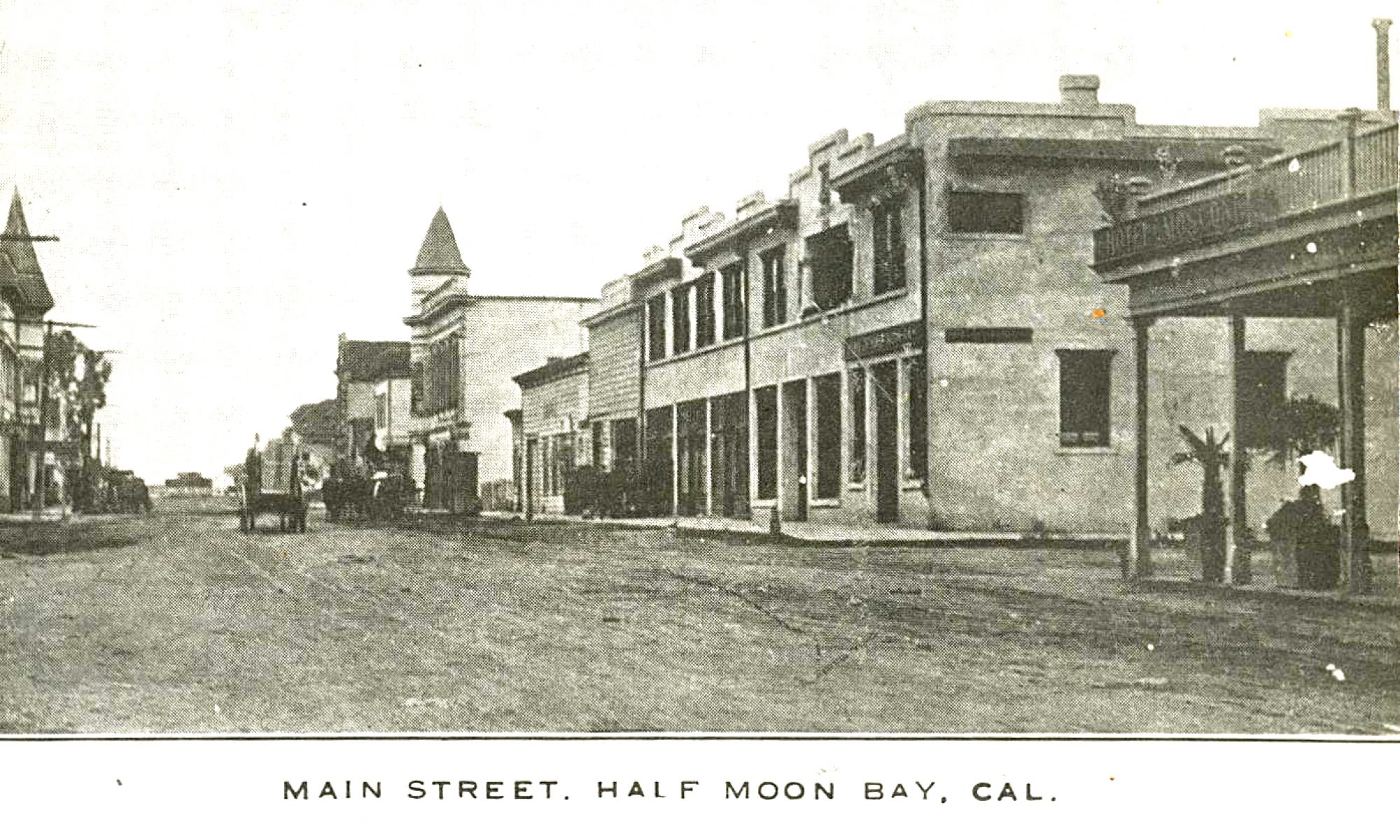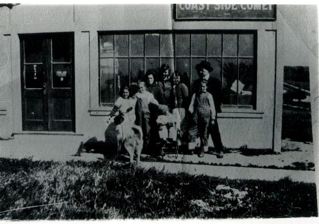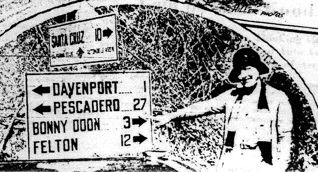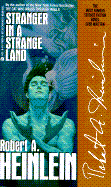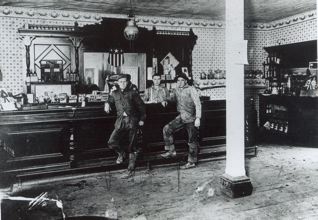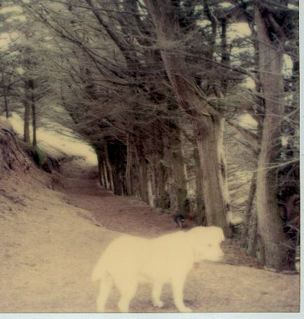
Bits of News From The Coastside Comet, February 4, 1916
Captain Hank Westfeldt–former deep sea fisherman, contracted with A. Cabari of the Princeton Inn to establish a steam launch at Princeton for tourists and fishing parties. Charges will be $1 with free bait.
[Note: Pete Douglas used to talk about the Westfeldt family and their antics–I almost didn’t believe they existed, but here is proof in the form of Captain Westfeldt).
D. Dianda of Granada – leased foothill property north of Granada
Ocean Shore Auto Stage Co.
J.M. Phillip of Granada is to build bathhouse near the Patroni House. Besides renting bathing suits, will stock notions, etc.
D. Pozzie, “artichoke king” of Montara.
Antone Gillis, 65, died in Miramar last Friday morning. Ran a grocery store last several years.
I Drive To Bonny Doon
Did I tell you Burt and I drove through Bonny Doon a couple of weeks ago, you know, where they make the delicious wine?
I hadn’t been there in many years and what stuck in my mind was apple trees, lots of apple trees but I didn’t find them. What I did find was a magical ride through light and dark (lots of dark because the redwoods are thick and mood-provoking here–which made me think of living in a small cabin and having to keep the lights on all day and the fire going which made me feel very cozy–and I wanted to stay but I was driving the car and there was no time to gather wood).
These days there aren’t many places where you can experience light and dark, dark and light, over and over, because so many of the trees that create the dark effect have been removed from the landscape. That means a lot of folks will never know that special feeling–and driving on a two-lane road with twists and turns and a heavy growth of redwoods, does awaken sleeping emotions and feelings.
When I think of Bonny Doon, I feel like it belongs to San Mateo County–but, you know, it doesn’t–it’s part of Santa Cruz County. It’s a secret kind of place…should I feel guilty talking about it? Secret because I didn’t see the turn off sign until I was upon it.
Here’s what I wanted to tell you before I forget: Did you know that the great science fiction writer Robert Heinlein and his wife Virginia lived in Bonny Doon? Maybe you know that Heinlein was the author of “Stranger in a Strange Land”. 1962 Hugo award winner.It was about a Martian who founded a religious movement on earth.
In the 1990s I was sitting in a dentist’s chair in San Mateo. Anaesthetic was being administered and as I was drifting away my dentist came to talk with me. He brought up Robert Heinlein, commenting that he had been a dear friend. (Heinlein died in Carmel in 1988 at age 80) My dentist then revealed that he often visited the Heinleins at Bonny Doon–my dentist knew a lot about the latest equipment, techniques and materials used in denistry, a field that has been changing rapidly, maybe more than any other medical field.
Anyway Heinlein was fascinated with the new materials being invented. Small, light, incredible things……
That was fascinating, I thought but then he added something more provactive, he said that the Heinleins were always naked when at home. They were probably living their writing, I thought as the anaesthetic put me into a gentle sleep.
You can’t I say I don’t tell you everything….
Favorite Commercials
I love these tv commercials, maybe you do, too. One of the reasons is the very cool music that accompanies
1. The Caveman Geico ad, the one where he’s on the moving “sidewalk” at the airport. Song is “Remind Me”, Royksopp
2. Horizon, “Watch me work, work, work…” There aren’t many words in this song but the words that give context have been edited out and those words are something like “Come to my bedroom. Watch me work, work….” “Sexy Results” Death From Above 1979 (MSTRKRFT Edition)
3. Sizzling Hot Cadillac commercial, “Punkrocker” featuring Iggy Pop, Teddybears, Soft Machine.
All at iTunes.
Let’s face it: Today’s American art can’t be appreciated in museums. It’s on tv, it’s the commercials, that’s where the state of American art is. And the music revolution has added a new dimension to them.
Was The Shingle King Murdered? Part III
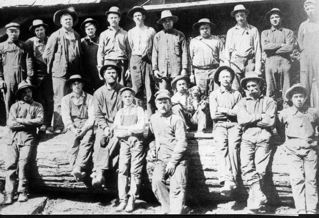 Hatch’s Mill, circa 1910. Photo: Ken Fisher
Hatch’s Mill, circa 1910. Photo: Ken Fisher
“The Purisima” (pardon me for spelling two different ways: Purissima, now Purisima) is located south of Half Moon Bay and west of present day tree-lined Skyline Blvd near somewhat remote Kings Mountain.
Purdy Pharis’s mill stood in the middle of nowhere and the frustration of moving large bundles of shingles to market quickly led to experimentation. After a while Purdy sought the services of an outside engineer who built a mile-long tramway and cable, with a lift of 1,000 feet, which transported hundreds of shingles from the depths of the beautiful canyon to the breathtaking mountaintop. But serious accidents put an abrupt end to the experiment.
Purdy wasn’t working alone in the Purisima. Besides his tough crew, in the immediate vicinity stood the famous George Borden and Rufus Hatch lumber mill. South of the top of Kings Mountain stood “Grabtown”–a temporary “village” and resting place for tired loggers moving wood from the dark green canyons to the busy port of Redwood City. To the west in the direction of the Pacific Ocean, where the forest abruptly ended, farmer Henry Dobbel was busy planting rows of potatoes that would be shipped to San Francisco.
After handling hundreds of thousands of shingles, Purdy Pharis was crowned the “Shingle King.”
But apparently the notoriety didn’t spoil him. When Purdy’s employees tried to demonstrate their esteem for him by shining his dirty boots, according to “Sawmills in the Redwoods,” Pharis seemed embarassed and looked for the nearest dust piles to dirty them once again.
…To Be Continued….
Was The Shingle King Murdered? Part II
It was the fall of 1853, and the stunning madrone trees’ berries were turning red when Purdy Pharis first set foot on Kings Mountain.
According to legend, he lost his way hiking in the trail-less forest. After wandering about all night, Purdy stumbled into a camp at sunrise and met a friendly fellow who was busily making shingles with a saw and axe. He was producing them from the redwood scraps left behind by the loggers–leftovers the lumbermen considered worthless.
The encounter led Purdy to conclude that a single person could handle the shingle business–in stark contrast to the lumber mill owners who had to hire different crews for each step, from the loggint to the finished lumber. Most enticing about shingle-making ws that not only could one person produce them, one person could carry them out of the isolated canyon riding a pack horse. By contrast, lumber mill owners had their hands full maneuvering the huge logs from the forest to market.
The book, “Sawmills in the Redwoods”, published by the San Mateo County History Museum in 1967, tells the story of the men who occupied the Peninsula’s redwood forest in those early years. Author Dr. Frank M. Stanger demonstrated how one man easily could manage the shingle business. In the book, he described how Purdy Pharis could have helped himself to a tree, chopped it down, sawed it into a shingle or shake-length blocks, and finally split the blocks into finished shingles or shakes.
After meeting that man in the logging camp, according to local lore, Purdy Pharis went into the shingle business for himself. He started on a small scale but when outside demand increased, Purdy expanded by establishing a shingle mill, with bunk and cookhouse in the beautiful and isolated, deep and narrow Purissima Canyon.
…To be continued…
Was The Shingle King Murdered? Part I
In 1884 a coroner’s jury determined that Sheldon Purdy Pharis had taen his own life at his Kings Mountain home–but some friends and neighbors remained skeptical, suspecting that the 55-year-old “Shingle King” actually might have been murdered.
At the time of his death, Purdy Pharis was a well-respected mill owner who had resided in the San Mateo County redwoods for more than three decades. He was a lifelong bachelor,a solitary fellow who loved the outdoors.
Purdy Pharis was 25 when he made the trek from his native New York to California in 1853, via the Isthmus of Panama. There was the mandatory short stint in the gold fields but Purdy never mined a nugget–the majestic redwoods south of San Francisco would shape his future.
A different kind of “gold rush” was taking place in the “City by the Bay”. There was an insatiable appetite for lumber to build houses, stores, hospitals and more.
The lumber was in a beautiful but remote forest of redwood trees on the Peninsula, next door to San Francisco. (Redwood, a treasured wood, is soft, resistant to rot and insects, and easy to work with).
A few lumber mills already had appeared, but getting the lumber out of the deep, narrow canyons was a monumental challenge–and the man who solved that problem could make a fortune.
…To be continued…
The Memories of Ralph Feusier, Part V: Conclusion
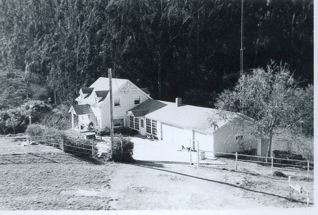 Locke/Nelson property, Higgins-Purissima Rd
Locke/Nelson property, Higgins-Purissima Rd
…Meanwhile at the Josiah Locke’s Purissima Canyon ranch, love was in the air. Flo’s brother, also called Horace, met and married Della Mae Johnson–the Coastside’s first woman dentist with offices in Pescadero and Half Moon Bay.
One day Ralph Feusier’s great grandfather, Henry Feusier, a United States Geological Surveyor (USGS), came to Half Moon Bay and met and married Flo’s sister, Emily. And it was through that union that Ralph, the retired insurance executive, has a connection to the house on Main Street.
Even before Ralph’s visit in 1930, Uncle Horace had demonstrated that he was much more than a farmer. During Prohibition Horace helped found the Bank of Half Moon Bay which had a branch office in Pescadero. In 1927 the two small town banks were taken over by A.P. Giannini’s famous Bank of America.
Always seeking a business challenge, Horace Nelson looked at Half Moon Bay’s water company, bought it and later sold it.
In 1938 Horace Nelson died at age 81 in Half Moon Bay. Ralph, then an adolescent, returned to the Coastside to attend his Uncle Horace’s funeral.
Ralph Feusier didn’t locate the house on Main Street on his visit more than 50 years later in 1993–but he didn’t return to New England empty-handed. I had provided him with a possible trail. Katherine Pitcher Valentine was a retired teacher and the daughter of John Pitcher, the pioneer Coastside judge. She had a wealth of knowledge about lcoal history. Ralph and Katherine talked on the phone.
“I spoke at length with Katherine Valentin,” Ralph wrote me. “She was a great friend of Carrie Reynolds, the housekeeper. David (brother of Josiah) Locke is buried in the Half Moon Bay Cemetery. When she visits her father’s grave, she always places flowers at David’s gravesite. I think she had fond affection for him.”
Most importantly, Mrs. Valentine had provided the essential clue–the location of the Nelson’s Victorian house. She placed it kitty-corner to what is now the lovely new Cetrella Restaurant on Main Street.
Finding the location of the Nelson house validated Ralph Feusier’s precious boyhood recollections. His search was complete–and he has since passed away.
